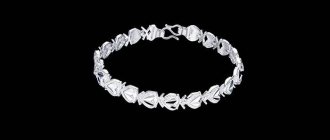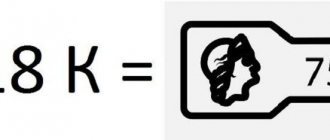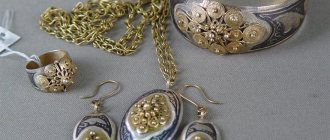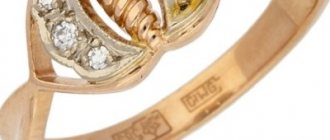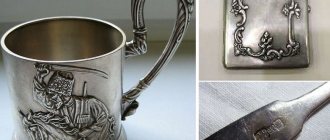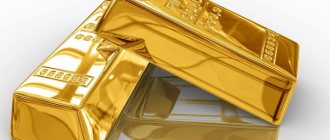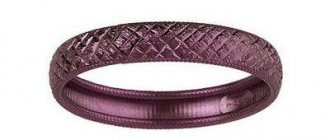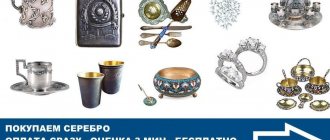The lack of awareness of the average person in the precious metals quotation system leaves room for scammers and unscrupulous sellers for speculation and substitution of concepts. And one of the most frequently asked questions is “is 925 gold or silver?” It is enough to plunge briefly into the topic of precious metals quotation to increase your competence in this matter and avoid unpleasant incidents.
What types of gold are there?
In Russia, precious metals presented on store shelves must be labeled. There are only 7 gold hallmarks. At present, some of them are outdated:
- 375. Precious metal content 37.5%. The rest is a ligature (admixture).
- 500. Contains 50% pure gold. It is rare nowadays.
- 583. Precious metal content 58.3%.
- 585. 58.5% precious metal. This includes 80% of jewelry sold.
- 750. Contains at least 75% pure gold. Widely distributed among exclusive jewelry and diamond jewelry.
- 958. 95.8% precious metal. A small number of such jewelry were produced in past centuries.
- 999. Pure gold. The metal is too soft, so it is not used in jewelry.
As you can see, 925 is not among them.
Vermeil versus gold plated and filled.
The main difference is that the base of vermeil jewelry is made of silver, while plated and filled jewelry can be made of a variety of metals.
For this reason, vermeil jewelry can be more valuable than comparable plated and filled jewelry made from a cheaper base metal or alloy.
Vermeil does not necessarily have a thicker layer of gold than plated jewelry.
For gold-filled jewelry, although the thickness of the plating can vary, it is often thicker than vermeil jewelry.
How to distinguish silver and white gold?
It is difficult to understand with the naked eye how silver differs from white gold. Reading the labels will help. New items - both silver and gold - can be the same color due to the finishing treatment - rhodium plating. Platinum group metal is applied to enhance shine and protect against darkening.
If there are no markings, you can check the quality of the metal at a pawnshop or workshop. The employee will conduct a rapid analysis using:
- Reagents. To check, you will need to file the product a little so that a fresh cut appears, onto which the reagent is applied. There should be no reaction when testing gold. If it passes, it means that the metal does not correspond to the declared standard. When checking silver, the cut area will acquire a reddish-brown tint. If this is not the case, it means that this is a product made from a different alloy.
- Touchstone. Alloys of precious metals are tested using individual rocks. The product is rubbed on the touchstone. If the trace left does not meet established standards, then the alloy contains a lower percentage of pure metal than stated.
- Electronic analyzer. Some stores, workshops or pawn shops have equipment that determines the exact percentage of precious metal content in the alloy. Rarely seen.
At home you can perform the following check:
- Paper. Draw metal along the sheet. Gold jewelry will not leave a mark, silver (even high, 925) should leave a dark stripe behind it.
- Acid. Pour a spoonful of vinegar into a glass of water and stir. After this, place the item being tested into the solution. If you have silver in front of you, the water will change color and become dark. The product itself will oxidize. This will not happen with gold: it is not afraid of an acidic environment.
- Iodine can be used to draw a stripe on an object. There will be no mark left on gold jewelry. If it is silver, the product will become stained and it will be difficult to remove the iodine.
How is vermeil jewelry made?
Vermeil, or simply silver plated, is a term used to refer to jewelry or other items made from silver and plated with gold. The word "vermeil" comes from the French and is pronounced "ver-may".
An alternative term is "silver gilt", which has the same meaning as "vermeil".
Gold-plated items are made by first creating a base of silver, which is then coated with a thin layer of gold.
The method used to apply gold to the surface of a product is called electrolysis.
Gold plating can be of varying degrees of purity, but in the United States there is a minimum requirement: to be considered gold plating, the gold plating must be at least 10 karats (equivalent to approximately 42% gold content).
Characteristics of 925 standard
The alloy contains several elements responsible for color and strength. This material is much harder than its counterparts.
Composition and properties
The 925 item is only 92.5% pure silver, the remaining 7.5% is copper. It is added to give the alloy greater strength. Thanks to impurities, even gold alloys become white and very similar to pure silver.
Allergy to nickel contained in the composition is common to many. Manifests itself in the form of dermatitis. Since 2000, the use of nickel in alloys has been prohibited in the European Union.
Strength
925 silver is durable and easy to process. Items made from this metal are less scratched. The alloy is practical and less likely to deform.
Castas (seats for the stone) in white alloys are made so that its krapana (legs that hold the stone) do not unbend and the inserts do not fall out, which is a common problem in products made from red and yellow materials.
Brand
The mark is responsible for who made the jewelry and in what year. The manufacturer applies a name at the final stage of production, after which it is handed over to the Assay Office, where the quality of the metal and the content of the required amount of pure silver are checked. If the percentage of content meets the standard, a sample is applied to the jewelry, for example 925.
Application
The strength of the alloy allows it to be used for the manufacture of watch parts and jewelry (bracelets, key rings).
Cost per gram
In order to find out how much one gram of 925 hallmark silver costs, you need to multiply its discount price by 0.925. Every day the average parameter is set by the Central Bank of the Russian Federation. The next day after entering a new indicator, the accounting departments of jewelry stores, pawnshops and credit institutions recalculate the cost of each product.
If sales and purchase transactions occur, market value is also taken into account. Usually it is higher, as it depends on certain risks and conditions. The price is also influenced by the manufacturing technology of the silver item, the weight and prestige of the manufacturer.
The price per gram depends on several parameters. Every year, the London Bullion Exchange publishes a rate of materials in specialized magazines, indicating the cost per ounce. As of March 2021, a jewelry store client had to pay 34.5 rubles for 1 g of 925 silver. The country of manufacture is also important. The most expensive jewelry is offered by Italians; among Chinese companies there are often low-quality alloys or fakes.
There is no gold graded 925, that alloy is silver. Owners of jewelry are often misled, as some items may be covered with gold plating. But the sample is placed directly on the object, and not on the shell. Sterling metal is strong, durable and has the ability to retain its original color and shine.
Tips for choosing jewelry of this sample
When choosing jewelry, you should pay attention to the presence of markings. All precious goods on store shelves must have manufacturer's tags with contact information and a retail chain price tag.
Expert opinion
Vsevolod Kozlovsky
6 years in jewelry making. Knows everything about samples and can identify a fake in 12 seconds
Please note the absence of piercing elements in the design of the model. The decoration should be comfortable and light. It is advisable that the stone (or path of stones) is not raised too high.
If the product contains diamonds over 4 mm in diameter, see if there is a certificate for the stone.
So what's the catch in testing?
The fact is that white gold is very easy to confuse with 925 silver if both products are plated with rhodium. In this case, there are several possibilities to determine what is in front of you - gold or silver. This is easy to do if you know a few nuances.
- Silver and gold have different grades.
We talked about them above. And, if you buy a product in hand, then first of all look inside. In gold jewelry, the hallmark is placed in an oval recess, while the silver hallmark is placed in a barrel-shaped figure. - As we have established, there is no such thing as 925 gold
. Therefore, we take a magnifying glass and examine the mark. - Let's look at the weight
. Silver products are always more massive than gold ones. After all, in order to make, for example, a gold ring more affordable, the manufacturer makes it inflated. It turns out that if you take a product made of gold and silver of the same size and style, then the silver one will weigh more. - The price of white gold is several times higher than that of silver
. If you are offered to buy a weighty white gold item at a low price, then most likely this is a scam.
If you buy jewelry secondhand, it is quite difficult at first, and even at second glance, to determine what is in front of you. There is another danger that instead of 925 silver, they will give you ordinary shiny metal or low-grade silver. And, if it is not possible to check the silver sample, then you can always check whether it is silver.
There are many ways to distinguish silver from counterfeit. Below are three of them.
- Magnet check.
Silver has no magnetic properties. It just won't attract. Most metals react to a magnet. - Properly processed silver will not leave any marks on a piece of paper if you move the jewelry over it.
If a dark mark remains on your fingers after you have rubbed it in your hands, feel free to return it to the seller. - Silver is a powerful heat conductor.
If you put earrings or a ring in boiling water, it will instantly become the same temperature as the water in the pan.
And the most important and important way, which is available to everyone, is to buy jewelry only in specialized stores. In this case, you don’t have to look at the tag or take out a magnifying glass, trying to figure out whether it’s 925 or 585?
Jewelry stores value their reputation. Therefore, they will not sell you a fake.
Reviews
Victoria, 32 years old: “For me personally, the main difference between silver and white gold is color. The silver is much lighter, the models are ordinary, almost unremarkable. White gold jewelry is dark, bright, and almost always encrusted with diamonds or semi-precious stones.”
Tatyana, 20 years old: “My beloved gave me a ring with a stone, I thought for a long time what kind of metal it was, until I took a magnifying glass and examined “925.” It turned out to be silver..."
Anna, 36 years old: “I don’t understand how to distinguish white gold from silver. As for me, they are exactly the same metals. And is it worth overpaying?
Svetlana, 28 years old: “I adore white gold, but only in its original color without any coatings. A little yellow looks natural and does not require additions. Silver is not for everybody.”
Sterling silver
Sterling silver is an alloy of silver and copper and corresponds to 925 fineness. A mixture of elements in this proportion gives the finished alloy an ideal appearance, high wear resistance and resistance to chemical attack. Sterling precious metal silver in its visual characteristics is practically no different from platinum and white gold.
Other variants of silver-based alloys are also known, but the alloy using copper is considered classic. An alloy of silver and platinum is more durable, but quickly darkens. Germanium in combination with silver completely eliminates the problem of darkening of silver products, but at the same time their cost increases critically. The use of cadmium in combination with silver ultimately brings the price of one gram of the finished product closer to the cost of a gram of high-quality gold. Therefore, sterling alloy today is the optimal price-quality ratio.
Silver is a fairly easy-to-work material; thanks to its natural plasticity, products made from it are particularly elegant and light.
Sterling silver 925 is used to produce elegant and sophisticated products that are in no way inferior in luxury to gold products. These are exquisite jewelry, key rings, cutlery, and accessories.
Very popular are cutlery, which is very durable and practical, since it does not require constant cleaning - silver of a lower standard begins to oxidize upon contact with food, which leads to a dark coating on the surface of the dishes and requires constant cleaning.
What determines the color of the sample?
Pure gold has a yellow color. Other shades are obtained by changing the ratio of metals in the alloy. For example, silver gives the alloy a green color, copper - a red tint, nickel, platinum and zinc - white. There are lemon, pink, orange, black and even purple alloys. They are obtained by changing the ratio of additional metals.
High quality varieties are only yellow in color, because... the proportion of the ligature is so small that it cannot affect the shade.
What is the difference between white, yellow and red gold?
The main colors of gold jewelry are yellow, white and red. The shade of the alloy is not related to the grade. For example, a ring with the mark 585 can be of any color. The changes concern only the ligature:
| Yellow | Red | White | |
| Gold | 585 | 585 | 585 |
| Silver | 187,5 | 80 | 225 |
| Copper | 227,5 | 335 | |
| Nickel | 165 |
To obtain a white tint, in addition to nickel, platinum and zinc are used.
Different colored alloys of the same grade have the same quality. However, the components of white gold - zinc and nickel - often cause allergic reactions. Jewelry with platinum is harmless and has a higher value than jewelry of other colors.
Blue, green and gray gold - truth or myth?
The high interest in gold jewelry of unusual shades has pushed jewelers to new experiments. With the help of various impurities, blue, light blue, gray, and black alloys are obtained. Sometimes yellow metal is coated with colored enamel, this simplifies and reduces the cost of obtaining a different color. However, such jewelry is short-lived and quickly becomes covered with scuffs and scratches.
Alchemists in the Middle Ages made blue gold by mixing the precious metal with iron. Modern experiments have shown that this alloy quickly rusts and turns brown.
Now blue and dark blue gold is made using iridium, gallium, and indium. This shade is also obtained using rhodium plating. Casting blue alloy is a labor-intensive and complex process and is more fragile than traditional jewelry. To obtain a gray color, jewelers mix pure precious metal with nickel and manganese.
A large amount of silver gives the metal a green tint. This alloy was found in the form of nuggets. Another name for this material is electrum. The first mentions of it date back to the 3rd millennium BC. Modern jewelers achieve a variety of shades from rich green to olive.
Where can I buy or sell?
Buying jewelry and investment gold involves risk. The safest option is to contact large jewelry stores and banks.
There are other places where you can not only buy, but also sell jewelry:
- private advertisements;
- pawnshops;
- market;
- small jewelry stores;
- Internet.
Such a purchase is fraught with risk: the product may be counterfeit, there will be no warranty, and if a defect is discovered, it cannot be returned. The purchase is justified only in the case of collecting antiques. It is better to sell jewelry in pawn shops or jewelry stores that buy metal.
The price of one gram of gold today depending on the standard
The price of the precious metal depends on the rate of the Central Bank, which determines the price of one gram of the highest grade metal. The assessment of lower samples is based on this cost. Let's look at current metal prices in rubles. The graph below shows the cost of 999 samples:
The price for the best one for jewelry is 750:
| Price 999 standard according to the Central Bank | Market value of the sample today | Scrap price | Price in jewelry |
As a conclusion, it can be noted that any gold alloy has a scope depending on its properties. In Russia, 585 and 750 samples of precious metal are popular.
Where is pure gold found?
There is no absolutely pure precious metal in nature. Nuggets contain impurities of other metals (silver, copper). Sample 999.9 is obtained only under industrial conditions. One hundred percent gold can only be obtained through a nuclear reaction by bombarding it with elementary mercury particles. The price of such an alloy will be astronomical.
Gold of 999.9 and 990 purity is used in the following areas:
- Production of bank bars and investment coins.
- To create a gold coating - gold leaf.
- In instrument making and microelectronics, high-grade material is used, which is a good neutral conductor and a means of thermal insulation.
